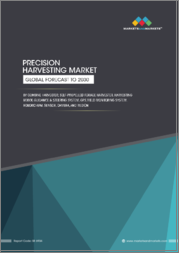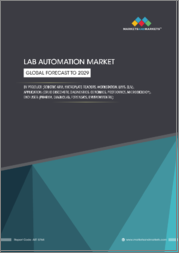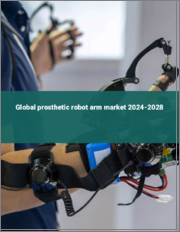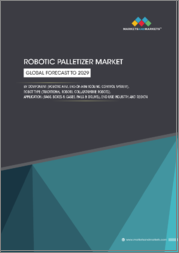
|
시장보고서
상품코드
1636032
세계의 중량물 운반용 로봇팔 시장 보고서 : 유형별, 중량별, 최종사용자별, 지역별(2025-2033년)Heavy Payload Robotic Arm Market Report by Type, Payload Capacity, End User, and Region 2025-2033 |
||||||
중량물 운반용 로봇팔 시장 세계 시장 규모는 2024년 134억 달러에 달했습니다. 향후 IMARC Group은 2033년에는 182억 달러에 달하고, 2025년부터 2033년까지 3.4%의 연평균 성장률(CAGR)을 나타낼 것으로 예상하고 있습니다. 고급차 판매 증가, 노동 안전에 대한 관심 증가, 첨단 기술 통합 등이 시장을 견인하는 주요 요인입니다.
중량물 운반용 로봇팔은 피킹, 배치, 기계 적재, 드릴링, 팔레타이징, 스프레이 등의 무거운 작업을 수행할 수 있습니다. 높은 힘과 토크를 견딜 수 있도록 강철, 알루미늄, 복합재 등 고강도 소재를 사용하여 제조됩니다. 힘 감지, 하중 균형 및 충돌 방지 기능을 갖추고 있어 무거운 적재물을 안전하고 정확하게 취급할 수 있습니다. 직원에게 위험한 작업을 수행하여 인간 작업자가 부상을 입을 위험을 줄이는 데 도움이 됩니다. 일반적으로 트럭이나 컨베이어에 무거운 물건을 싣고 내리고, 무거운 부품을 조립하고, 대형 구조물을 용접하고, 무거운 부품을 가공하는 데 사용됩니다. 현재 중량물 운반용 로봇 팔은 다양한 산업의 요구 사항에 맞게 사용자 정의 할 수 있습니다.
중량물 운반용 로봇팔 시장 동향 :
자동차의 다양한 부품을 제조하고 작업자의 생산성을 향상시키기 위해 자동차 산업에서 중량물 운반용 로봇팔의 채용이 증가하고 있습니다. 이는 소득 수준 상승에 따른 고급차 판매량 증가와 함께 세계 시장 성장을 강화하는 주요 요인 중 하나가 되고 있습니다. 또한, 근로자의 안전에 대한 관심 증가와 최소한의 운영 비용에 대한 요구가 증가하면서 시장에 긍정적인 영향을 미치고 있습니다. 또한, 건설 업계에서는 건축자재 적재 및 하역을 위해 중량물 운반용 로봇팔이 사용되고 있습니다. 이는 주거, 상업, 산업 공간에서의 건설 활동 증가와 함께 시장 성장에 긍정적인 영향을 미치고 있습니다. 이와는 별도로, 농작물 심기 및 수확, 가축 취급 및 운반 등의 작업을 수행하기 위해 농업 산업에서 중량물 운반 로봇 팔의 사용이 증가하고 있는 것도 시장 성장에 기여하고 있습니다. 또한, 중량물 운반용 로봇팔의 정확도와 효율성을 높이기 위해 인공지능(AI), 머신러닝(ML), 센서, 제어시스템의 탑재가 증가하고 있습니다. 또한, 중량물 취급 및 고정밀 작업 수행과 관련된 힘과 움직임의 측정 및 제어가 가능해졌습니다. 이는 위험한 환경에서 작업을 수행하기 위해 원격으로 조작할 수 있는 중량물 운반용 로봇 팔의 출현과 함께 시장에 대한 밝은 전망을 낳고 있습니다.
본 보고서에서 다룬 주요 질문
- 전 세계 중량물 운반용 로봇팔 시장은 지금까지 어떻게 성장해왔고, 앞으로 어떻게 변화할 것인가?
- 중량물 운반용 로봇팔 시장 세계 시장에서의 촉진요인, 억제요인 및 기회는 무엇인가?
- 주요 지역 시장은?
- 무게 운반용 로봇팔 시장에서 가장 매력적인 국가는?
- 유형별 시장 분석은?
- 수송 가능 중량별 시장 현황은?
- 최종 사용자별 시장 분석은?
- 전 세계 중량물 운반용 로봇팔 시장 경쟁 구도는?
- 중량물 운반용 로봇팔 시장 세계 시장에서의 주요 기업은?
목차
제1장 서문
제2장 조사 범위와 조사 방법
- 조사 목적
- 이해관계자
- 데이터 소스
- 1차 정보
- 2차 정보
- 시장 추정
- 보텀업 접근
- 톱다운 접근
- 조사 방법
제3장 주요 요약
제4장 서론
- 개요
- 주요 업계 동향
제5장 세계의 중량물 운반용 로봇팔 시장
- 시장 개요
- 시장 실적
- COVID-19의 영향
- 시장 예측
제6장 시장 분석 : 유형별
- 다관절
- 시장 동향
- 시장 예측
- 직교좌표
- 시장 동향
- 시장 예측
- SCARA
- 시장 동향
- 시장 예측
- 원통좌표
- 시장 동향
- 시장 예측
- 기타
- 시장 동향
- 시장 예측
제7장 시장 분석 : 운반 중량별
- 500-700kg
- 시장 동향
- 시장 예측
- 701-1,000kg
- 시장 동향
- 시장 예측
- 1,001-3,000kg
- 시장 동향
- 시장 예측
- 3,001kg 이상
- 시장 동향
- 시장 예측
제8장 시장 분석 : 최종사용자별
- 자동차
- 시장 동향
- 시장 예측
- 기계
- 시장 동향
- 시장 예측
- 광업
- 시장 동향
- 시장 예측
- 기타
- 시장 동향
- 시장 예측
제9장 시장 분석 : 지역별
- 북미
- 미국
- 캐나다
- 아시아태평양
- 중국
- 일본
- 인도
- 한국
- 호주
- 인도네시아
- 기타
- 유럽
- 독일
- 프랑스
- 영국
- 이탈리아
- 스페인
- 러시아
- 기타
- 라틴아메리카
- 브라질
- 멕시코
- 기타
- 중동 및 아프리카
제10장 성장 촉진요인 및 억제요인과 기회
- 개요
- 성장 촉진요인
- 성장 억제요인
- 기회
제11장 밸류체인 분석
제12장 Porter의 Five Forces 분석
- 개요
- 바이어의 교섭력
- 공급 기업의 교섭력
- 경쟁 정도
- 신규 진출업체의 위협
- 대체품의 위협
제13장 가격 분석
제14장 경쟁 구도
- 시장 구조
- 주요 기업
- 주요 기업 개요
- ABB Ltd.
- Ellison Technologies Inc.(Mitsui & Co., Ltd.)
- FANUC Corporation
- Kawasaki Heavy Industries Ltd.
- KUKA AG(Midea Group)
- Nachi-Fujikoshi Corp.
- Stellantis N.V.
- Vulcan Engineering Co.
- Yaskawa Electric Corporation
The global heavy payload robotic arm market size reached USD 13.4 Billion in 2024. Looking forward, IMARC Group expects the market to reach USD 18.2 Billion by 2033, exhibiting a growth rate (CAGR) of 3.4% during 2025-2033. The increasing sales of luxury vehicles, growing concerns for labor safety, and integration of advanced technologies represent some of the key factors driving the market.
Heavy payload robotic arm is capable of performing heavy-duty tasks, such as picking and placing, machine loading, drilling, palletizing, and spraying. It is manufactured using high-strength materials, including steel, aluminum, and composites, to withstand high forces or torques. It is equipped with force sensing, load balancing, and collision avoidance features to handle heavy payloads safely and accurately. It aids in reducing the risk of injuries to human workers by performing tasks that would be dangerous to employees. It is generally used for loading and unloading heavy materials on trucks or conveyors, assembling heavy components, welding large structures, and machining heavy parts. At present, the heavy payload robotic arm can be customized to meet the requirements of different industries.
Heavy Payload Robotic Arm Market Trends:
There is an increase in the adoption of heavy payload robotic arms in the automotive industry for manufacturing different components of vehicles and improving the productivity of workers. This, coupled with the rising sales of luxury vehicles on account of inflating income levels, represents one of the major factors strengthening the growth of the market around the world. Moreover, the growing concerns for labor safety and the increasing need for minimal operational costs are influencing the market positively. In addition, heavy payload robotic arms are employed in the construction industry to load and unload construction materials. This, along with the increasing construction activities in residential, commercial, and industrial spaces, is favoring the market growth. Apart from this, the rising utilization of heavy payload robotic arms in the agriculture industry to perform tasks, such as planting or harvesting crops and handling and transporting livestock, is contributing to the market growth. Furthermore, there is an increase in the incorporation of artificial intelligence (AI), machine learning (ML), sensors, and control systems in the heavy payload robotic arms to improve their accuracy and efficiency. They also enable measuring and controlling the forces and movements involved in handling heavy loads and performing tasks with high precision. This, coupled with the advent of heavy payload robotic arms that can be operated remotely to perform tasks in hazardous environments, is creating a positive outlook for the market.
Key Market Segmentation:
Type Insights:
- Articulated
- Cartesian
- SCARA
- Cylindrical
- Others
Payload Capacity Insights:
- 500-700 Kg
- 701-1,000 Kg
- 1,001-3,000 Kg
- 3,001 Kg and Above
End User Insights:
- Automotive
- Machinery
- Mining
- Others
Regional Insights:
- North America
- United States
- Canada
- Asia-Pacific
- China
- Japan
- India
- South Korea
- Australia
- Indonesia
- Others
- Europe
- Germany
- France
- United Kingdom
- Italy
- Spain
- Russia
- Others
- Latin America
- Brazil
- Mexico
- Others
- Middle East and Africa
- The report has also provided a comprehensive analysis of all the major regional markets that include North America (the United States and Canada), Asia Pacific (China, Japan, India, South Korea, Australia, Indonesia, and others), Europe (Germany, France, United Kingdom, Italy, Spain, Russia, and others), Latin America (Brazil, Mexico, and others), and the Middle East and Africa. According to the report, Asia Pacific was the largest market for heavy payload robotic arm. Some of the factors driving the Asia Pacific heavy payload robotic arm market included rapid urbanization and industrialization, integration of advanced technologies, increasing sales of vehicles, etc.
Competitive Landscape:
- The report has also provided a comprehensive analysis of the competitive landscape in the global heavy payload robotic arm market. Detailed profiles of all major companies have also been provided. Some of the companies covered include ABB Ltd., Ellison Technologies Inc. (Mitsui & Co., Ltd.), FANUC Corporation, Kawasaki Heavy Industries Ltd., KUKA AG (Midea Group), Nachi-Fujikoshi Corp., Stellantis N.V., Vulcan Engineering Co., Yaskawa Electric Corporation, etc. Kindly note that this only represents a partial list of companies, and the complete list has been provided in the report.
Key Questions Answered in This Report:
- How has the global heavy payload robotic arm market performed so far and how will it perform in the coming years?
- What are the drivers, restraints, and opportunities in the global heavy payload robotic arm market?
- What are the key regional markets?
- Which countries represent the most attractive heavy payload robotic arm markets?
- What is the breakup of the market based on the type?
- What is the breakup of the market based on the payload capacity?
- What is the breakup of the market based on the end user?
- What is the competitive structure of the global heavy payload robotic arm market?
- Who are the key players/companies in the global heavy payload robotic arm market?
Table of Contents
1 Preface
2 Scope and Methodology
- 2.1 Objectives of the Study
- 2.2 Stakeholders
- 2.3 Data Sources
- 2.3.1 Primary Sources
- 2.3.2 Secondary Sources
- 2.4 Market Estimation
- 2.4.1 Bottom-Up Approach
- 2.4.2 Top-Down Approach
- 2.5 Forecasting Methodology
3 Executive Summary
4 Introduction
- 4.1 Overview
- 4.2 Key Industry Trends
5 Global Heavy Payload Robotic Arm Market
- 5.1 Market Overview
- 5.2 Market Performance
- 5.3 Impact of COVID-19
- 5.4 Market Forecast
6 Market Breakup by Type
- 6.1 Articulated
- 6.1.1 Market Trends
- 6.1.2 Market Forecast
- 6.2 Cartesian
- 6.2.1 Market Trends
- 6.2.2 Market Forecast
- 6.3 SCARA
- 6.3.1 Market Trends
- 6.3.2 Market Forecast
- 6.4 Cylindrical
- 6.4.1 Market Trends
- 6.4.2 Market Forecast
- 6.5 Others
- 6.5.1 Market Trends
- 6.5.2 Market Forecast
7 Market Breakup by Payload Capacity
- 7.1 500-700 Kg
- 7.1.1 Market Trends
- 7.1.2 Market Forecast
- 7.2 701-1,000 Kg
- 7.2.1 Market Trends
- 7.2.2 Market Forecast
- 7.3 1,001-3,000 Kg
- 7.3.1 Market Trends
- 7.3.2 Market Forecast
- 7.4 3,001 Kg and Above
- 7.4.1 Market Trends
- 7.4.2 Market Forecast
8 Market Breakup by End User
- 8.1 Automotive
- 8.1.1 Market Trends
- 8.1.2 Market Forecast
- 8.2 Machinery
- 8.2.1 Market Trends
- 8.2.2 Market Forecast
- 8.3 Mining
- 8.3.1 Market Trends
- 8.3.2 Market Forecast
- 8.4 Others
- 8.4.1 Market Trends
- 8.4.2 Market Forecast
9 Market Breakup by Region
- 9.1 North America
- 9.1.1 United States
- 9.1.1.1 Market Trends
- 9.1.1.2 Market Forecast
- 9.1.2 Canada
- 9.1.2.1 Market Trends
- 9.1.2.2 Market Forecast
- 9.1.1 United States
- 9.2 Asia-Pacific
- 9.2.1 China
- 9.2.1.1 Market Trends
- 9.2.1.2 Market Forecast
- 9.2.2 Japan
- 9.2.2.1 Market Trends
- 9.2.2.2 Market Forecast
- 9.2.3 India
- 9.2.3.1 Market Trends
- 9.2.3.2 Market Forecast
- 9.2.4 South Korea
- 9.2.4.1 Market Trends
- 9.2.4.2 Market Forecast
- 9.2.5 Australia
- 9.2.5.1 Market Trends
- 9.2.5.2 Market Forecast
- 9.2.6 Indonesia
- 9.2.6.1 Market Trends
- 9.2.6.2 Market Forecast
- 9.2.7 Others
- 9.2.7.1 Market Trends
- 9.2.7.2 Market Forecast
- 9.2.1 China
- 9.3 Europe
- 9.3.1 Germany
- 9.3.1.1 Market Trends
- 9.3.1.2 Market Forecast
- 9.3.2 France
- 9.3.2.1 Market Trends
- 9.3.2.2 Market Forecast
- 9.3.3 United Kingdom
- 9.3.3.1 Market Trends
- 9.3.3.2 Market Forecast
- 9.3.4 Italy
- 9.3.4.1 Market Trends
- 9.3.4.2 Market Forecast
- 9.3.5 Spain
- 9.3.5.1 Market Trends
- 9.3.5.2 Market Forecast
- 9.3.6 Russia
- 9.3.6.1 Market Trends
- 9.3.6.2 Market Forecast
- 9.3.7 Others
- 9.3.7.1 Market Trends
- 9.3.7.2 Market Forecast
- 9.3.1 Germany
- 9.4 Latin America
- 9.4.1 Brazil
- 9.4.1.1 Market Trends
- 9.4.1.2 Market Forecast
- 9.4.2 Mexico
- 9.4.2.1 Market Trends
- 9.4.2.2 Market Forecast
- 9.4.3 Others
- 9.4.3.1 Market Trends
- 9.4.3.2 Market Forecast
- 9.4.1 Brazil
- 9.5 Middle East and Africa
- 9.5.1 Market Trends
- 9.5.2 Market Breakup by Country
- 9.5.3 Market Forecast
10 Drivers, Restraints, and Opportunities
- 10.1 Overview
- 10.2 Drivers
- 10.3 Restraints
- 10.4 Opportunities
11 Value Chain Analysis
12 Porters Five Forces Analysis
- 12.1 Overview
- 12.2 Bargaining Power of Buyers
- 12.3 Bargaining Power of Suppliers
- 12.4 Degree of Competition
- 12.5 Threat of New Entrants
- 12.6 Threat of Substitutes
13 Price Analysis
14 Competitive Landscape
- 14.1 Market Structure
- 14.2 Key Players
- 14.3 Profiles of Key Players
- 14.3.1 ABB Ltd.
- 14.3.1.1 Company Overview
- 14.3.1.2 Product Portfolio
- 14.3.1.3 Financials
- 14.3.1.4 SWOT Analysis
- 14.3.2 Ellison Technologies Inc. (Mitsui & Co., Ltd.)
- 14.3.2.1 Company Overview
- 14.3.2.2 Product Portfolio
- 14.3.3 FANUC Corporation
- 14.3.3.1 Company Overview
- 14.3.3.2 Product Portfolio
- 14.3.3.3 Financials
- 14.3.3.4 SWOT Analysis
- 14.3.4 Kawasaki Heavy Industries Ltd.
- 14.3.4.1 Company Overview
- 14.3.4.2 Product Portfolio
- 14.3.4.3 Financials
- 14.3.4.4 SWOT Analysis
- 14.3.5 KUKA AG (Midea Group)
- 14.3.5.1 Company Overview
- 14.3.5.2 Product Portfolio
- 14.3.5.3 Financials
- 14.3.5.4 SWOT Analysis
- 14.3.6 Nachi-Fujikoshi Corp.
- 14.3.6.1 Company Overview
- 14.3.6.2 Product Portfolio
- 14.3.6.3 Financials
- 14.3.6.4 SWOT Analysis
- 14.3.7 Stellantis N.V.
- 14.3.7.1 Company Overview
- 14.3.7.2 Product Portfolio
- 14.3.8 Vulcan Engineering Co.
- 14.3.8.1 Company Overview
- 14.3.8.2 Product Portfolio
- 14.3.9 Yaskawa Electric Corporation
- 14.3.9.1 Company Overview
- 14.3.9.2 Product Portfolio
- 14.3.9.3 Financials
- 14.3.1 ABB Ltd.
Kindly note that this only represents a partial list of companies, and the complete list has been provided in the report.



















